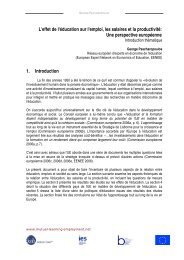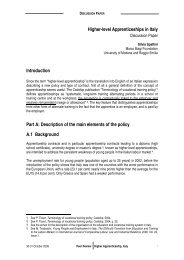The Active Labour Market Policy Reform – The Second Wave
The Active Labour Market Policy Reform – The Second Wave
The Active Labour Market Policy Reform – The Second Wave
You also want an ePaper? Increase the reach of your titles
YUMPU automatically turns print PDFs into web optimized ePapers that Google loves.
May 13-14, 2004<br />
EXECUTIVE SUMMARY<br />
Denmark<br />
<strong>The</strong> Finnish labour market system is comparable to that of the other Scandinavian countries<br />
and there are similar developments in Denmark, e.g. regarding the merging of employment<br />
services and social security offices into a one-stop shop. <strong>The</strong>re is currently a large scale<br />
reform of the regional and local government system underway in Denmark in which the<br />
position of the PES is not entirely clear. <strong>The</strong> likely scenario is that employment services will<br />
be administered by the local authorities with considerable influence taken by the national<br />
level. It is also likely that the public employment services and social services will be merged.<br />
One of the arguments for merging the two in Denmark is that the social services have a<br />
poorer performance record than the PES. However, merging them removes the possibility of<br />
comparison and benchmarking, thus potentially reducing competition and quality. Regarding<br />
transferability, the Danish expert felt that the Finnish papers did not offer enough empirical<br />
insight into the programmes to be able to form a proper opinion. He also presented a model<br />
which showed that the performance of the Finnish PES has decreased to some extent<br />
during the reform years. By calculating the ratio of the vacancies filled by the PES out of the<br />
total number of vacancies filled, we get an impression of the efficiency of the PES in filling<br />
vacancies. Even if corrected for the unemployment rate, the performance of the PES has<br />
decreased during the period of reforms. Although this may not indicate that the reforms have<br />
been ineffective, it certainly calls for a closer look at this issue. <strong>The</strong> Danish expert also<br />
elaborated on the ‘threat effect’ of active labour market measures, i.e. the unemployed tend<br />
to more actively seek work when they are under threat of having to participate in a LM<br />
measure. This should be taken into account in the evaluation of the second wave of reforms.<br />
France<br />
France has been experiencing an economic slowdown accompanied by rising<br />
unemployment and a decrease in salaried workers (older workers retiring from the labour<br />
market) since mid-2001. <strong>The</strong> main instrument for getting people back to work is the Return<br />
to Work Action Plan (PARE) established in July 2001. Under this programme, the job-seeker<br />
develops a Personalised Action Plan for a New Start (PAP-ND) and has the opportunity of<br />
participating in a number of active measures to help him or her back into a job. <strong>The</strong><br />
programme is based on a tripartite agreement between state, UNEDIC (employment<br />
insurance fund) and ANPE (national employment agency) and involves private reintegration<br />
services as well. <strong>The</strong> coordination between UNEDIC (insurance benefit), employment policy,<br />
training policy and social security benefits is important as is the decentralisation of the<br />
administration from the central to the regional and local levels.<br />
Regarding transferability, France has opted for a universal rather than a dual approach<br />
targeting all job-seekers whether they receive unemployment benefit or not. Nevertheless<br />
some of the same issues arise such as the need for improved profiling and avoiding<br />
fragmentation between those job-seekers on benefits and those who are not.<br />
Peer Review <strong>The</strong> <strong>Active</strong> <strong>Labour</strong> <strong>Market</strong> <strong>Policy</strong> <strong>Reform</strong> <strong>–</strong><br />
<strong>The</strong> <strong>Second</strong> <strong>Wave</strong><br />
11





